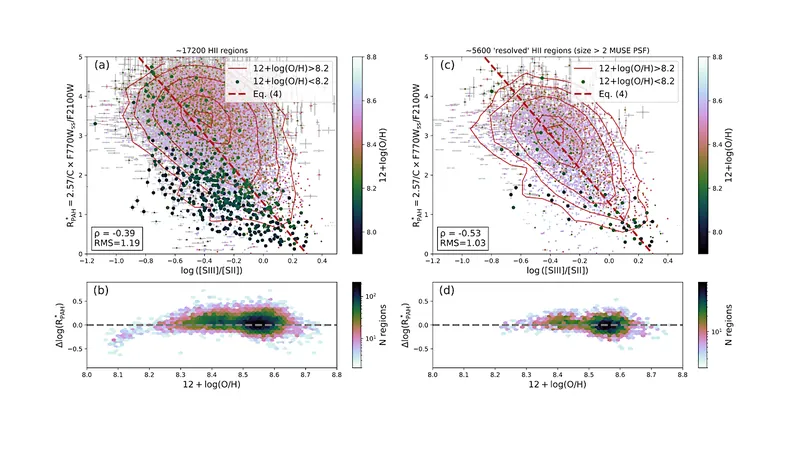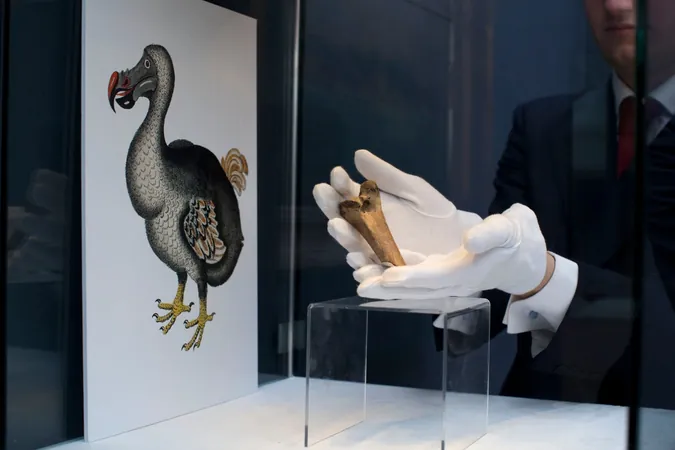
Unlocking the Cosmic Mystery: How Stars Destroy Polycyclic Aromatic Hydrocarbons
2025-09-22
Author: Benjamin
The Secrets of Polycyclic Aromatic Hydrocarbons (PAHs) Unveiled
Polycyclic aromatic hydrocarbons (PAHs) are fascinating organic compounds that are prevalent in the interstellar medium (ISM) of galaxies with Solar metallicity. They are not just any molecules; PAHs play a crucial role in regulating ISM heating, cooling, and the reprocessing of stellar radiation.
New Insights from the PHANGS Survey
Recent observations from the James Webb Space Telescope (JWST) and MUSE have shone new light on the behavior of PAH fractions across 42 galaxies participating in the PHANGS survey. By analyzing data from over 17,000 H II regions, researchers have discovered that the PAH fraction, which is essentially the relative abundance of PAHs in total dust mass, is significantly lower in these regions compared to other, less ionized areas of the ISM.
A Tangled Relationship: PAHs and Ionization
Intriguingly, the study highlighted a strong anti-correlation between PAH fractions in H II regions and local ionization parameters when metal levels exceed 12+log(O/H) > 8.2. This suggests that the destruction of PAHs is intricately linked to the presence of ionized gas and hydrogen-ionizing UV radiation.
Metallicity Matters: The Decline of PAHs in Less Metal-Rich Regions
At lower metallicities, researchers observed a sharp decline in PAH fractions in both H II regions and the diffuse ISM. This decline is likely a by-product of less efficient PAH formation in environments that are low in metals, offering a glimpse into the cosmic chemistry that shapes our universe.
The Role of Supernova Remnants in PAH Destruction
By isolating dust emissions near optically identified supernova remnants, the study found clear evidence of selective PAH destruction. Although the differences in PAH fractions were indistinguishable at scales of about 50 parsecs, the overarching conclusion points to ionizing radiation as the main culprit behind PAH destruction within H II regions.
The Bigger Picture: What This Means for Astrophysics
These findings not only enhance our understanding of PAHs but also underscore the importance of metallicity in determining their abundance across galaxies. As cosmologists unravel the enigmatic role of these compounds, we inch closer to understanding the complex dynamics of star formation and evolution in our universe.









 Brasil (PT)
Brasil (PT)
 Canada (EN)
Canada (EN)
 Chile (ES)
Chile (ES)
 Česko (CS)
Česko (CS)
 대한민국 (KO)
대한민국 (KO)
 España (ES)
España (ES)
 France (FR)
France (FR)
 Hong Kong (EN)
Hong Kong (EN)
 Italia (IT)
Italia (IT)
 日本 (JA)
日本 (JA)
 Magyarország (HU)
Magyarország (HU)
 Norge (NO)
Norge (NO)
 Polska (PL)
Polska (PL)
 Schweiz (DE)
Schweiz (DE)
 Singapore (EN)
Singapore (EN)
 Sverige (SV)
Sverige (SV)
 Suomi (FI)
Suomi (FI)
 Türkiye (TR)
Türkiye (TR)
 الإمارات العربية المتحدة (AR)
الإمارات العربية المتحدة (AR)